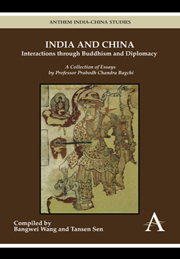 India and China: Interactions through Buddhism and Diplomacy
India and China: Interactions through Buddhism and Diplomacy Book contents
- Frontmatter
- Contents
- Compilers' Note
- Introduction (English and Chinese)
- Part One
- 1 Ancient Chinese Names of India
- 2 The Beginnings of Buddhism in China
- 3 Indian Influence on Chinese Thought
- 4 A Note on the Avadānaśataka and its Chinese Translation
- 5 Bodhisattva-śīla of Śubhākarasiṁha
- 6 A Fragment of the Kāśyapa Saṁhitā in Chinese
- 7 The Chinese Mysticism
- 8 Some Early Buddhist Missionaries of Persia in China
- 9 Some Letters of Hiuan-Tsang and his Indian Friends
- 10 New Lights on the Chinese Inscriptions of Bodhgayā
- 11 A Buddhist Monk of Nālandā amongst the Western Turks
- 12 Political Relations between Bengal and China in the Pathan Period
- 13 Chinese Coins from Tanjore
- 14 Report on a New Hoard of Chinese Coins
- 15 Ki-pin and Kashmir
- 16 Sino-Indian Relations – The Period of the United Empires (618–1100 A.D.)
- Part Two Short Articles
- Part Three Articles in Bengali
- Appendix
- Index
4 - A Note on the Avadānaśataka and its Chinese Translation
from Part One
Published online by Cambridge University Press: 05 March 2012
- Frontmatter
- Contents
- Compilers' Note
- Introduction (English and Chinese)
- Part One
- 1 Ancient Chinese Names of India
- 2 The Beginnings of Buddhism in China
- 3 Indian Influence on Chinese Thought
- 4 A Note on the Avadānaśataka and its Chinese Translation
- 5 Bodhisattva-śīla of Śubhākarasiṁha
- 6 A Fragment of the Kāśyapa Saṁhitā in Chinese
- 7 The Chinese Mysticism
- 8 Some Early Buddhist Missionaries of Persia in China
- 9 Some Letters of Hiuan-Tsang and his Indian Friends
- 10 New Lights on the Chinese Inscriptions of Bodhgayā
- 11 A Buddhist Monk of Nālandā amongst the Western Turks
- 12 Political Relations between Bengal and China in the Pathan Period
- 13 Chinese Coins from Tanjore
- 14 Report on a New Hoard of Chinese Coins
- 15 Ki-pin and Kashmir
- 16 Sino-Indian Relations – The Period of the United Empires (618–1100 A.D.)
- Part Two Short Articles
- Part Three Articles in Bengali
- Appendix
- Index
Summary
While comparing the Avādanas with the Jātaka Stories Dr. Speyer says: “The avadāna type is nearly related to the Jātaka. Both concern edifying tales told with the purpose of inculcating moral precepts as taught by the Saddharma revealed by the Buddhas”. The stories of the Avadānaśataka have also the same character. Some of the stories may be labelled as Jātaka proper. A Jātaka, judged by the Pāli collection of Jātaka stories, contains a story of the past “within the outer frame-work, constituted by the introductory episode and the concluding identification”. A large number of stories of the Avadānaśataka contains a past story, within the frame-work of a present one with the identification. This identification is in some cases with the Buddha himself, and in other cases less important persons. Thus the presence of such different types of stories in the Avadānaśataka shows the importance of the collection in the development of the Jātaka stories.
The Chinese translation of the Avadānaśataka is very ancient. The title of the translation in Chinese is called Chuan tsi pai yuan king. The translation is attributed to Upasāka Che-kien of the Yue-che country. Che-kien was an Indo-Scythian Upasāka and is mentioned as such in all the Chinese Buddhist sources. It is said that he was at first at Lo-yang but on account of the political upheaval towards the end of the reign of Han Hien-ti (190–220 A.D.) was compelled to leave the north and to go to the south.
- Type
- Chapter
- Information
- India and China: Interactions through Buddhism and DiplomacyA Collection of Essays by Professor Prabodh Chandra Bagchi, pp. 43 - 48Publisher: Anthem PressPrint publication year: 2011


